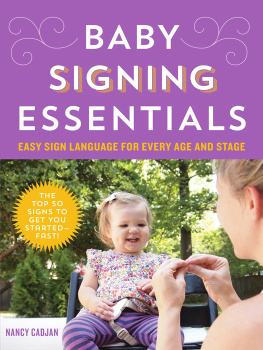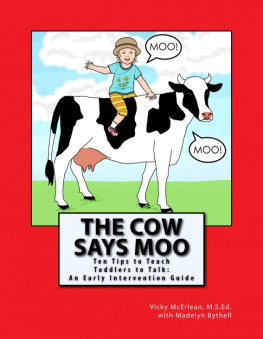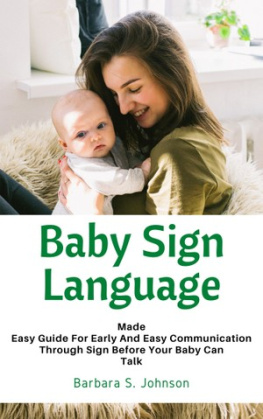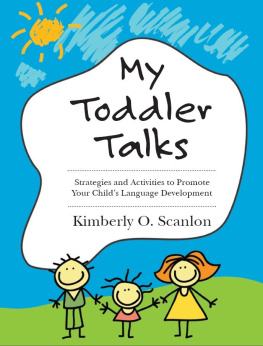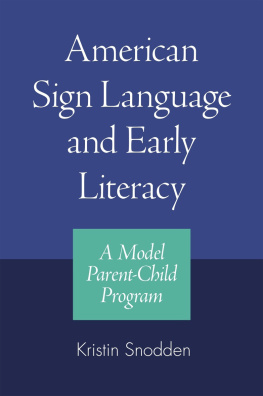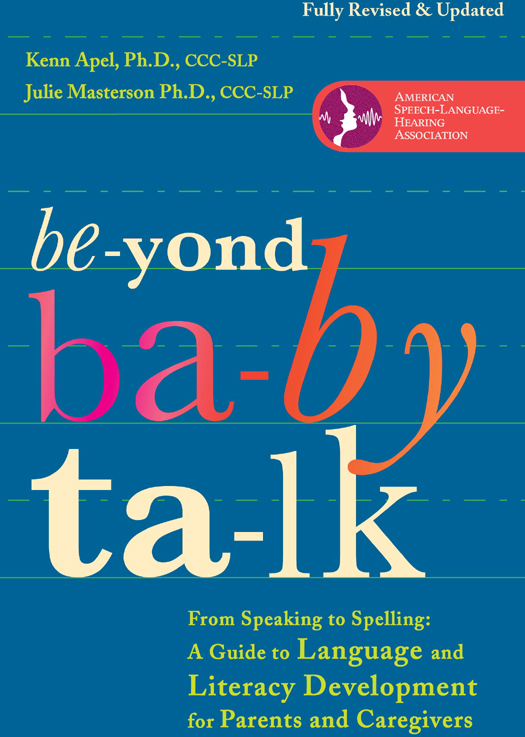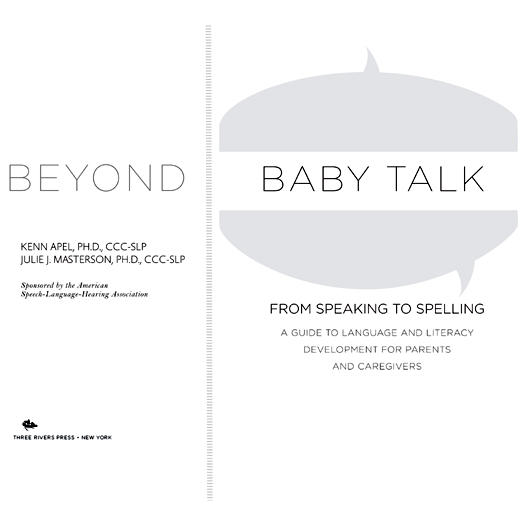Copyright 2001, 2012 by the American
Speech-Language-Hearing Association
All rights reserved.
Published in the United States by Three Rivers Press, an imprint of the Crown Publishing Group, a division of Random House, Inc., New York.
www.threeriverspress.com
www.crownpublishing.com
THREE RIVERS PRESS and the Tugboat design are registered trademarks of Random House, Inc.
This revised edition, minus its photographs, was originally published in paperback in the United States by Prima Publishing, a division of Random House, Inc., Roseville, California, in 2001, and subsequently reprinted that same year in paperback by Three Rivers Press, an imprint of the Crown Publishing Group, a division of Random House, Inc., New York.
Library of Congress Cataloging-in-Publication
Data is available upon request
eISBN: 978-0-307-95229-5
COVER DESIGN BY JIM MASSEY
v3.1
To Lynda and Jerry, for their love and support,
and to our children and grandchildren, for bringing
joy and wonder to our lifes work
CONTENTS
HOW DOES YOUR CHILD HEAR AND TALK?
Children develop at their own pace. This checklist shows the average ages when most children have developed these skills. Your child might not have all skills until the end of the age range.
Take this checklist with you to doctor checkups and day care or school meetings. Use it to talk about your childs understanding and talking skills.
H EARING AND U NDERSTANDING
BIRTH3 MONTHS
Startles to loud sounds.
Quiets or smiles when you talk.
Seems to recognize your voice and quiets if crying.
46 MONTHS
Moves eyes in direction of sounds.
Notices toys that make sounds.
Pays attention to music.
Responds to changes in tone of your voice.
7 MONTHS1 YEAR
Turns and looks in direction of sounds.
Looks when you point.
Turns to own name when you call.
Recognizes words for familiar objects and people, like cup, truck, juice, and daddy.
Begins to respond to simple words and phrases, like No, Come here, and Want more?
Plays games with you, like peekaboo and pat-a-cake.
Listens to songs and stories for a short time.
12 YEARS
Points to a few body parts when you ask.
Follows 1-part directions, like Roll the ball or Kiss the baby.
Understands simple questions, like Whos that? and Wheres your shoe?
12 YEARS
Listens to stories, songs, and rhymes for a longer time.
Points to pictures in books when you name them.
23 YEARS
Understands opposite words, like gostop, biglittle, and updown.
Follows 2-part directions, like Get the spoon and put it on the table.
Understands new words quickly.
34 YEARS
Responds when you call from another room.
Understands words for some colors, like red, blue, and green.
Understands words for some shapes, like circle and square.
Understands words for family, like brother, grandmother, and aunt.
45 YEARS
Understands words for order, like first, next, and last.
Understands words for time, like yesterday, today, and tomorrow.
Follows longer directions, like Put your pajamas on, brush your teeth, and then pick out a book.
Follows classroom directions, like Draw a circle on your paper around something you eat.
Understands most of what is said at home and at school.
T ALKING
BIRTH3 MONTHS
Makes cooing sounds.
Has different cries for different needs.
Smiles at people.
M ONTHS
Coos and babbles when playing alone or with you.
Makes speech-like babbling sounds, like pa, ba, and mi.
M ONTHS
Giggles and laughs.
Makes sounds when happy or upset.
M ONTHS1 Y EAR
Babbles longer strings of sounds, like mimi upup babababa.
Uses sounds and gestures to get and keep attention.
Points to objects and shows them to others.
Uses gestures like waving bye-bye, reaching to be picked up, or shaking head no.
Imitates different speech sounds.
Says 1 or 2 words, like hi, dog, dada, mama, or uh-oh, around first birthday. All words may not be clear.
Y EARS
Uses a lot of new words.
Uses p, b, m, h, and w in words.
Starts to name pictures in books.
Asks what, who, and where questions, like Whats that? Whos that? and Wheres kitty?
Puts 2 words together, like More apple, No bedtime, and Mommy book.
Y EARS
Has a word for familiar people, places, things, and actions.
Talks about things that are not in the room.
Talks during pretend play, like saying beep-beep when moving cars.
Uses k, g, f, t, d, and n in words.
Uses words like in, on, and under.
Asks why?
Familiar people understand your childs speech.
Puts 3 words together to talk about and ask for things.
May repeat some words and sounds.
Y EARS
Answers simple who, what, and where questions.
Says rhyming words, like hat-cat and silly-billy.
Uses pronouns, like I, you, me, we, and they.
Uses some plural words, like toys, birds, and buses.
Most people understand your childs speech.
Asks when and how questions.
Puts 4 words together. May make some mistakes, like I goed to school.
Talks about what happened during the day. Uses about 4 sentences at a time.
Y EARS
Says all speech sounds in words. May make mistakes on sounds that are harder to say, like l, s, r, v, z, j, ch, sh, and th.
Responds to What did you say?
Talks without repeating words or sounds most of the time.
Names letters and numbers.
Uses sentences that have more than 1 action word, like jump, play, and get. May make some mistakes, like Zach gots 2 video games, but I got 1.
Tells a short story.
Keeps a conversation going.
Talks in different ways depending on the listener and place. May use short sentences with younger children or talk louder outside than inside.
S PEECH -L ANGUAGE P ATHOLOGISTS AND A UDIOLOGISTS C AN H ELP !
A speech-language pathologist or audiologist can help if you are concerned. Dont wait. Its better to get help early.
G ET H ELP FROM AN A UDIOLOGIST W HEN
You checked no to most of the hearing and understanding items for your childs age.
Your child does not seem to hear or respond to you.
Your child needs the TV or radio volume to be much louder than others.
Talk to your childs doctor if your child pulls or tugs at his or her ear, cries more than usual, and doesnt respond to sounds. Your doctor can check to see if your child has an ear infection.
G ET HELP FROM A S PEECH- L ANGUAGE P ATHOLOGIST WHEN
You checked no to most of the talking items for your childs age.
Your child stops talking or playing with you.
You have concerns or questions about stuttering. Your child gets upset about sounds or words not coming out.


